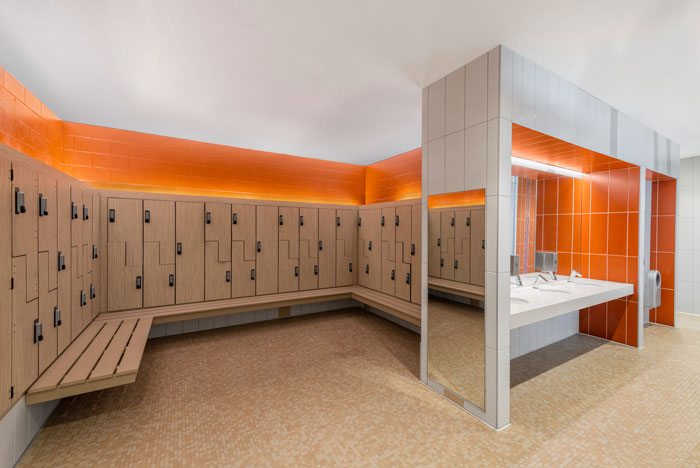Municipal or private, large or small, old or new, users of the tennis center or recreation, gym or aquatic center (or all three in one) want a place to shower, sit in a sauna, shave, change into athletic gear or at the least store coats and keys and purses and phones.
Operators have many decisions to make about locker room spaces when renovating or providing input to a new build. There is layout to consider, as well as size, materials, utility costs, durability and convenience, all in the context of user needs and budget.
The evolution of these spaces has mainly taken place within the municipal and private rather than the education arena. You still may see communal showers and boxy metal lockers that use padlocks and combination locks in K-12 schools, but where people pay for memberships, the trend is attractive and comfortable and convenient. Managers also choose guided by cultural shifts, as universal and inclusive changing spaces have picked up momentum in recent years.
A Space for Everyone
According to Donaldo Visani, a senior principal with OLC, there is a growing demand for facilities to provide
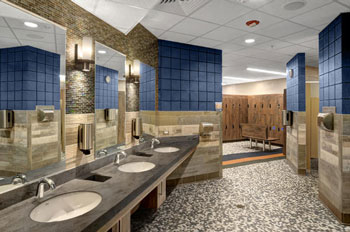
universal or gender-neutral changing areas, including private changing rooms with showers, sinks and toilets in addition to or in lieu of men’s and women’s locker rooms.
“A typical layout includes several of these rooms within a larger mixed-gender area that consists of circulation, lockers and vanity spaces available to all,” Visani said. “A mix of changing, shower and toilet options is particularly popular for aquatic centers, since these can increase throughput capacity and address the needs of a broad demographic spectrum.
“When designing new facilities or renovating existing ones, it is important to realize that there are many options for how to provide for the needs of the user based on the facility type, the demographics and climate.”
Aesthetic Considerations
“One of the trends we have noticed in locker rooms is the creation of a more spa-like environment,” said Lindsay Hoffman, president of a manufacturer of swimsuit water extractors. “This can be achieved by offering more amenities, softening harsh lighting and by using higher-end materials for the lockers and counter spaces and flooring.
“We have also seen the reinforcing of brand in locker rooms. Especially in recreational locker rooms tied to teams, team logos and colors are often incorporated throughout the locker room.”
Facility managers are paying more attention to locker rooms in general, said Rylie Davidson, an interior designer for BRS Architecture, because users make membership decisions based on the quality and cleanliness of the locker room alone. Davidson said there is a greater expectation for a luxury or upscale experience with improved amenities, and facilities are investing more and more into these spaces to keep up.
“Along with the look and feel of the locker room, the material options have expanded and evolved even over the last 10 years,” she said. “Finishes are becoming more durable, water-resistant and lately more cleanable than ever. This is such a huge factor in high-traffic environments like this where water is constantly present and cleanliness is on everyone’s mind.”
Metal lockers can be made more attractive and better able to withstand humid locker room climates by using galvannealed steel. A price upgrade, galvannealed steel lends a sort of rustproofing, as well as a more attractive finish, according to Steve Troyano, a national product manager for a locker room manufacturer.
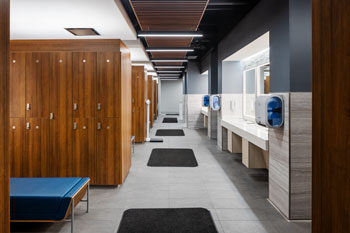
For clients who want a more durable, easier-to-clean locker with numerous color and finish options, phenolic material is becoming more popular and common, said Troyano. He calls phenolic’s chemical-resistant finishes “indestructible” in high-use and aquatic facility locker rooms.
“It’s the perfect locker for those environments,” Troyano said of phenolic surfacing. “It’s a great return on investment for the end user. They’re usually paying 5% to 10% more, but they know those lockers are going to be there for years and years. If you wanted a more sophisticated-looking locker room, phenolic might be the way to go. When we’re getting away from the school areas, the places that like to look a little more professional, upscale, it would make sense for them.”
The next level up from phenolic, which can be given a wood-simulated finish, is actual wood. Troyano said larger universities and higher-end clubs might choose that material for their teams and members as they spare no expense to create a more luxurious space.
Before the material for the lockers is selected, the locker room design and layout and type of foundation for the lockers has to be determined. Davidson said that when operators choose where to save money and where to spend more, her firm suggests not scrimping on what lockers are attached to.
“One place we recommend splurging is opting for concrete block instead of framed walls in the locker room space,” she said. “Concrete block provides extreme durability that can be the difference between a space lasting 10 years and 30 years. The higher upfront cost associated with this choice can be offset by the long-term savings of lower maintenance costs and a longer building lifespan.”
Mind the Budget
Davidson said there are several ways to keep costs low without sacrificing design or square footage. Her company typically specifies porcelain fixtures such as the toilet and sink as a basic model, leaving more money to put toward what she called “intentional wow” moments. She said another way to keep costs low is to choose a basic wall tile and play with color, texture or orientation to create eye-catching patterns.
Tom Carosello is the executive director of the Estes Valley Recreation and Park District in Estes Park, Colo., and has been a part of six public-sector locker room renovations or builds. He said his favorite money-saving decisions involve water and electricity usage.
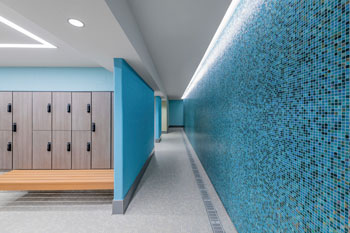
“I highly recommend installing low-flow plumbing fixtures, occupancy sensors and LED lighting whenever possible, as utility costs are always a huge factor in any facility’s budget,” said Carosello. “We estimate a savings of approximately 7% to 10% in our overall utility costs per year—water, gas and electric—as low-flow fixtures typically use at least 20% less water than traditional fixtures, plus there is less of a demand to heat as much water.
“While 7% to 10% may not sound like much, it equates to approximately $15,000 to $20,000 in energy and utility savings each year for our facility.”
Carosello said practicality, safety and comfort guided most choices in design and materials, where to spend and where to save. Members are front of mind for decision-making, he said, but staff wasn’t far behind.
“We wanted to ensure our spaces were safe and attractive to our patrons, but also efficient from a maintenance and monitoring standpoint,” said Carosello. “As a result, we chose a design which minimizes tight angles and concave surfaces to make it easier to clean, and also located the entrances so they are easily visible from our front desk. We also installed ‘quick change’ and dry lockers as close to the entrances as we could to eliminate the need for patrons utilizing these areas to walk through potentially wet areas.”
Other locker room tips Carosello has picked up along the way:
- Utilize grout, paint and caulking colors that are easily matched and in good supply.
- Incorporate custodial closets within the locker room itself so that maintenance, cleaning and stocking needs are easily met without having to bring in tools and supplies from other areas of the facility.
- Be sure to look ahead and take community and/or facility membership growth into consideration when finalizing plans.
“I would say the main lessons I have learned entail spending a little more up front to put durability, safety and comfort above glitz,” he said. “While tile flooring, synthetic lockers, and counters, acrylic paint and concrete are typically more expensive, in the long run they will hold up very well against everyday wear and tear and are also easier to clean and maintain than drywall, wood and other traditional materials.
“Ample lighting and comfortable seating are also important factors, as inadequate or ‘cheap’ selections in these areas are sure to get low marks among patrons.”
Angela Wong Brown, deputy community services administrator for the city of Palm Beach Gardens, Fla., has her own list of lessons learned from locker room projects over the years:
- Do not include light switches inside group locker rooms—only occupancy sensors in each space.
- Do not include dead bolts inside group restrooms.
- Include sound attenuation between rooms that is installed prior to utilities and mechanical and electrical going in.
- Direct connect electrical components of faucets or else you’ll be changing out batteries.
- Water-test all floor drains prior to final flooring installation.
All main and branch lines to the sewer system should be videotaped before final flooring goes in just in case of dips in the line that aren’t discovered until after the facility is in use.
Lock It Up
Where there are lockers there are locks, and today’s locks are increasingly set into each locker, opened and locked
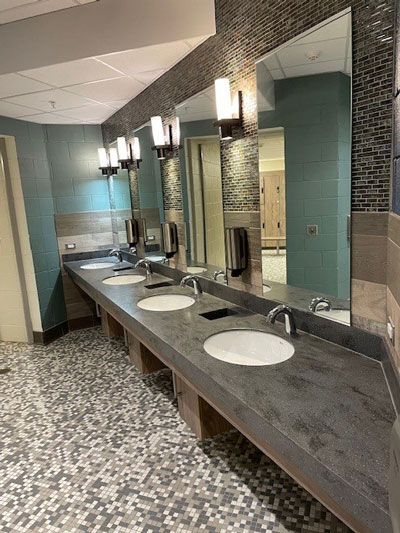
through a variety of technologies designed for user convenience.
Matt Welty, vice president of a lock manufacturer, said today’s lock options cover a wide portfolio of innovative, standalone keyless door locks and access products for a range of growing markets, including lockers and cabinets.
These include stylish push-button mechanical locks, digital electronic locks and smart solutions, which are easy for users to manage and operate using a keypad, card and smartphone.
“In the past five years, we have seen a steep migration toward higher-end products,” Welty said. “More private recreation facility users are desiring an increase in amenities, leading to a change from low-end steel lockers with keys to RFID or personal four-digit codes. Aesthetics has also led this charge with special hooks for clothes, phone charging ports and more inside these lockers.”
Welty said clients have been asking for locker room environments that are equal to where they work and live. He said they don’t want their users to feel like they are in an old high school locker room with steel lockers and turning combination locks, but a more sophisticated space.
Even though these are public locker rooms, users want a high-end feel.
For budgetary consideration, mechanical versus electronic can make a big difference, said Welty, and it is important for clients to understand the future mobility of their locker room space. “Don’t make choices that lock you into using the same thing one, five or even 10 years from now because once you go to make changes, it could be more costly in the long run,” he said. “Choosing locks that allow for future upgrades without needing to change or remanufacture the physical locker can save a lot.
“It is crucial to think about the future. Will there be a push from mechanical to electronic locks? Will RFID cards be provided to the members and new locks needed? Focusing on both short-term and long-term goals can help make informed decisions.”
Welty said users also need to consider the maintenance of the equipment over time with questions like: Do the locks allow for easy battery changes without having to remove any devices? And can they be cleaned easily without damaging the lock?
“Technology will play a huge part in the future of locker room design,” said Welty. “The ability for locks to be touchless and not having to remember codes will continue to become more popular. Aesthetics will also continue to be important.”
Traffic Trends
Before managers make decisions on the look of the locker room, Visani said they should think about the trends his
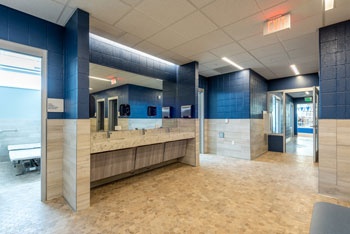
firm has noticed in locker room traffic and what it might mean for design and fixture choices. The past seven to eight years have seen a decline in locker room usage, Visani said, as more and more facility users come to the center already dressed for their intended activity.
“This trend has resulted in a slight overall reduction in locker room area as a percentage of the overall facility,” he said. “The popularity of security, express lockers and cubbies has also reduced the need for traditional locker rooms.
“Other interior design trends include: the move away from wood lockers and carpeting to more durable, brighter, and cleanable materials; the move away from full-height lockers to wider lockers with two or more doors per vertical; more attention to privacy during the dressing and showering process, with individual shower stalls now being the norm; and the trend toward creating a spa-like feel within the locker rooms.”
Visani said the present and future of locker rooms may be in flux but is nevertheless bright, as long as operators continue to stay abreast of community and member needs.
“Universal changing rooms will continue to develop in popularity,” he said. “This approach addresses the common needs of all users within an open environment yet delivers comfort and privacy where and when it is needed. Designers will continue to provide facilities that respond to the needs of patrons for an inclusive, efficient, safe and sociable lockering experience.” RM



